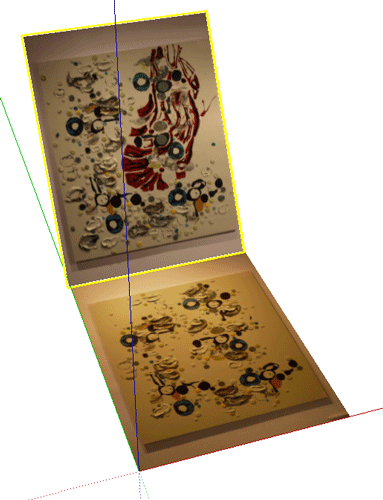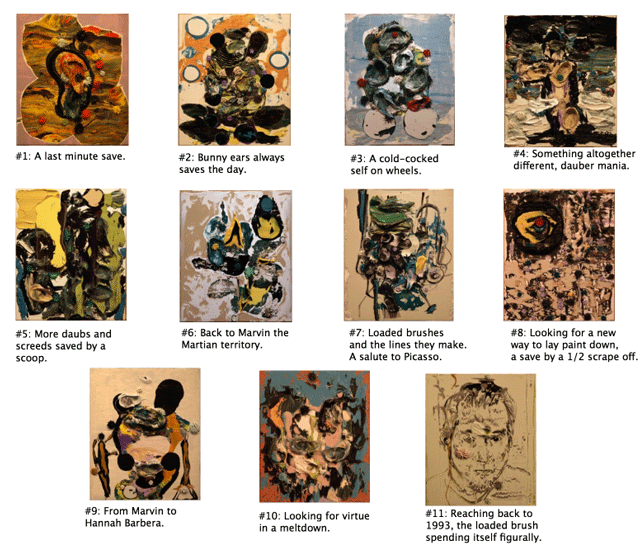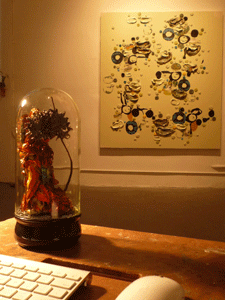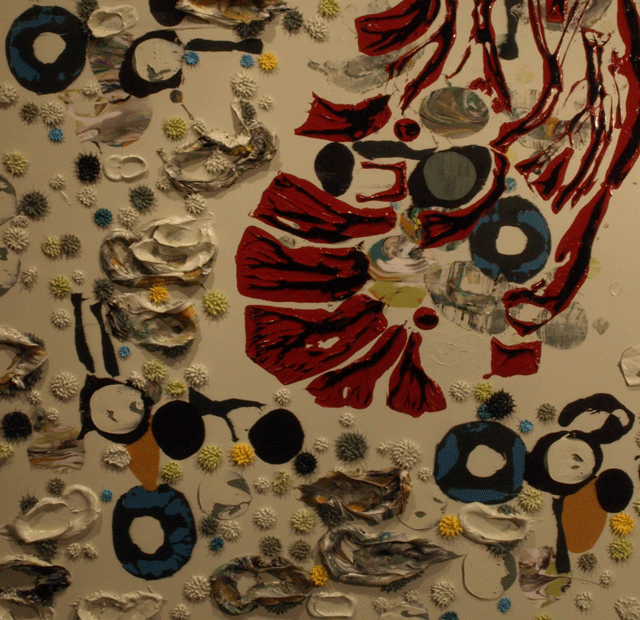April 16, 2009
The Big Lick

I've been talking about breaking the egg for some time now. This is a reference to the imperative to challenge oneself in the studio, to fracture one's creative narrative, something I believe that is incumbent for artists of all stripes. An artist has to grow and make the turn into new territory, otherwise we are merely mindless automatons churning out worthless product, pathetic superficial masturbation. The degree of fracture is a personal decision, and I think that the art world is diverse enough to encompass a broad range of egg cracking. This, all to the glory of civilization, amen.
Still, this is the tough part of an artist's life. Breaking one's egg is generally not a pleasant experience. Relinquishing one's pattern, I think that everyone would agree: in that way, pain lies. The bigger question is how much of a break is a legitimate crack of one's mental universe? Back in 2003, I had a show at the erstwhile Chac Mool Gallery in West Hollywood, LA. I didn't blog it at the time, but the opening was graced by the presence of the great Robert Rauschenberg (Why not? Some type of modesty, I suppose.). Rauschenberg was kind enough to impart a quantum of advice: "Always make things differently. Keep changing." At that moment, my first thought was that while he himself could fly the flag of the cracked egg, his oeuvre was remarkably uniform in terms of the continuity of the kind of choices and changes that he characteristically employed. My second thought was the example of artists like Jonathan Lasker, whose singular determination was remarkable and impressive. (I had met him once or twice before, but never did I get the warm-fuzzies that radiated naturally from the likes of Rauschenberg.) Thus, I had found another compass, the poles of Robert Rauschenberg and Jonathan Lasker.
While the question of how much rupture one should endure is a personal one for every artist, the danger remains: the hazard of breaking the yolk. The strain of creativity is real, as most artists can attest to the specter of mental depression that can haunt a studio. The possibility that creative destruction can also unleash a kind of personal destruction is real. That the crisis will not find it's release in epiphany, that one's creative reservoir has been depleted, that you are not all what you had hoped you could be, that you might fall desperately short of the standard of the great exemplars of art history... all these monsters lurk beneath the thin veneer of confidence that we use to navigate the social art world.

So it was that I found myself here in the spring of 2009 wrestling as always with the mandate of egg cracking, looking for some elbow room in my project. Bart Exposito and I have been talking about how each of us were wrestling with our own respective eggs, each of us feeling particularly besieged recently. I stayed with the works on paper, experiments for me are best worked out on paper since failures that result in scrape offs have a lesser psychic cost when the scales are smaller, and risk is therefore more easily forded. The image above is a gloss of how the train of thought traveled.
(Bart, by the way, had popped out the other side with a brilliant resolution of his efforts, his initial small format canvases can be seen here, here and here.)
After eleven WOPS (works on paper) were digested in dribs and drabs, it was high time to work large, and in I went. I didn't feel as if I had a particular breakthrough to carry from the recent WOP cycle that could inform the larger painting, so I decided to paint an overall composition, floating elements in a kind of colloidal suspension, the challenge of which would have been a delicacy of touches, a cloud of paint licks. Unfortunately, the marks that I had made were larger than they should have been, the first touch led the way in scale and I followed through hoping the journey would finally bear fruit. It was good enough result, albeit dammed as it was by faint praise. I let it stand and hung it on the wall. It, after all, was in a tradition of similar paintings that I have engaged in before, I was hoping that this apology would be sufficient.

Friends would visit the studio and I would note their reactions. When Andrew Hahn first saw the painting, he said: "Dennis, what if you scraped it all down. Wouldn't that be interesting, the residue of your marks?" I choked down the implied critique, my apprehensions were becoming confirmed. Other friends simply ignored it, preferring to view other paintings in the studio. Another confirmation by omission. One character, a friend of a friend, had a more guttural response. He was one of those scrappy bohemian artists with several rehabs under his belt, an apparent devotee of Charles Bukowski. Characters like this tend not to like the lyricism in my work. His response was almost violent. "That green. I don't see anything there. THIS PAINTING SUCKS." Got it. Thanks. Now you can leave.
Then Bart sat in a chair in the studio later in the night after we closed Hop Louie, our favorite local bar. He looked at me in the eye, took a long drag of his cigarette and said: "You copped out, didn't you?" I was determined not to flinch. Damn. "You're right, Bart. I give up. I'm on my back like a possum, you can have your way with me. You're right." A beat, two. "You're right." Even later, in Andrew studio (he didn't hear Bart's evaluation), he said: "What you need to do is plant a big lick on that painting."

So I did. I mean, I didn't intend to plant a tongue on the canvas, despite the apparent resemblance. I knew that I had to clear out some space for some intrusive act. I didn't want to scrape it off, there was much I liked about it as it was. A new move had to be simultaneously independent and integrated into what was already there. So I surgically removed each feature and planted them to the side, recalling the peeled paintings from last year. Julian Schnabel's typical swaths of swooping clotted color was hovering in my head, but there was no way I was going to imitate the overbearing-bed robed-obnoxious genius so slavishly. Indeed, in so much as my all-over type of compositions tend to recall Claude Monet's water lilies, I was thinking of a huge carp swimming into the visual field. It was only later, when Andrew was looking at the finished piece, he said: "Hey, did you paint an actual tongue?" I nodded. Andrew generally doesn't like to know what the imagistic associations that abstract painters conjure in their work, such chatter makes him cranky. So I was surprised he asked. I didn't think of a tongue again until he mentioned it, but no doubt, there it was. What I didn't tell him at the time was that it was a tongue... and a fish... and a Schnabel smack down... and a cascade of red imprintations, flecked in black.
Whatever one sees, there it is. Imagination. That's what art is all about, right?
Posted by Dennis at April 16, 2009 4:24 PM
Leave a comment